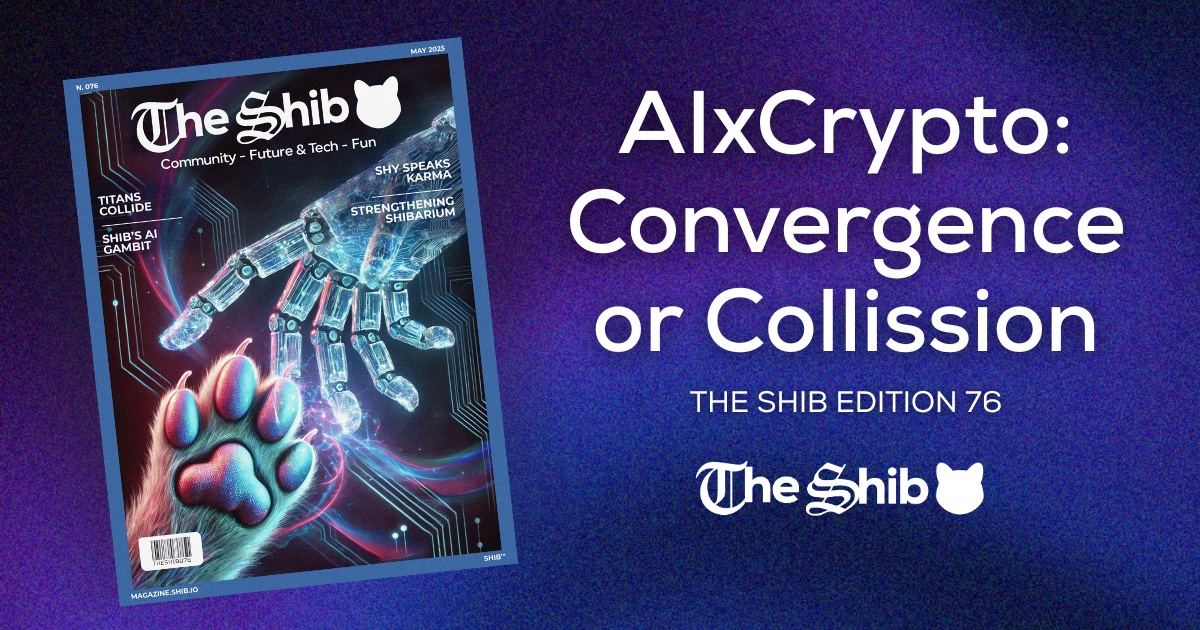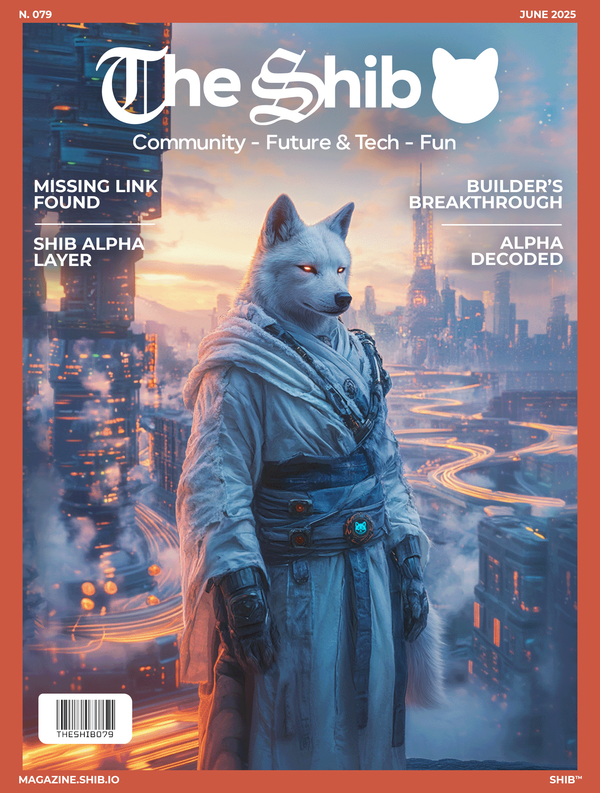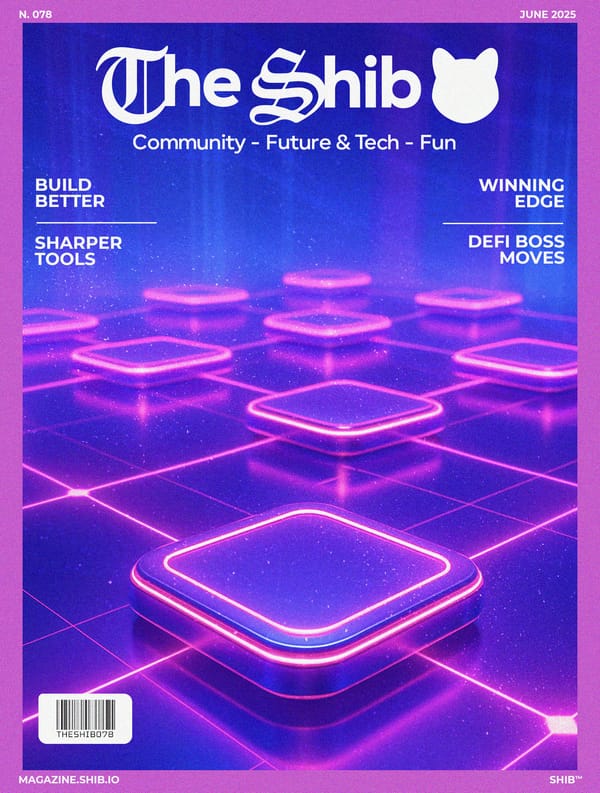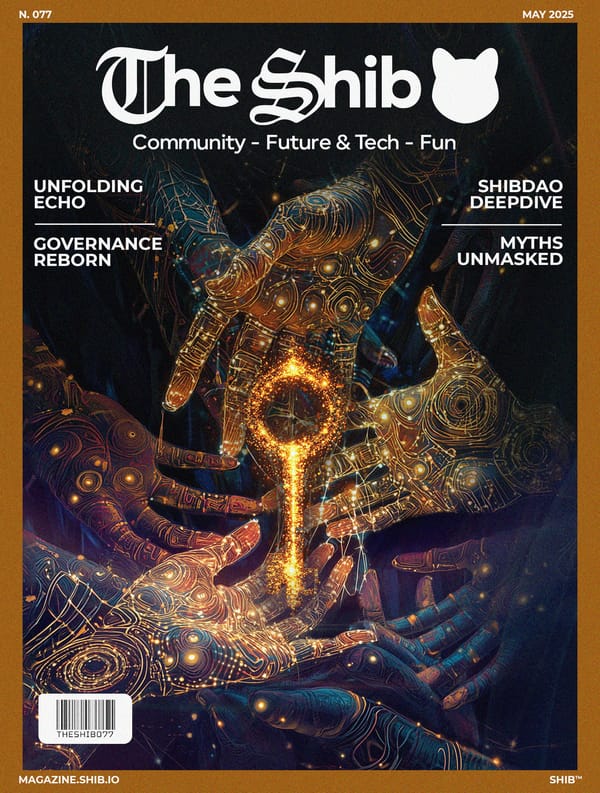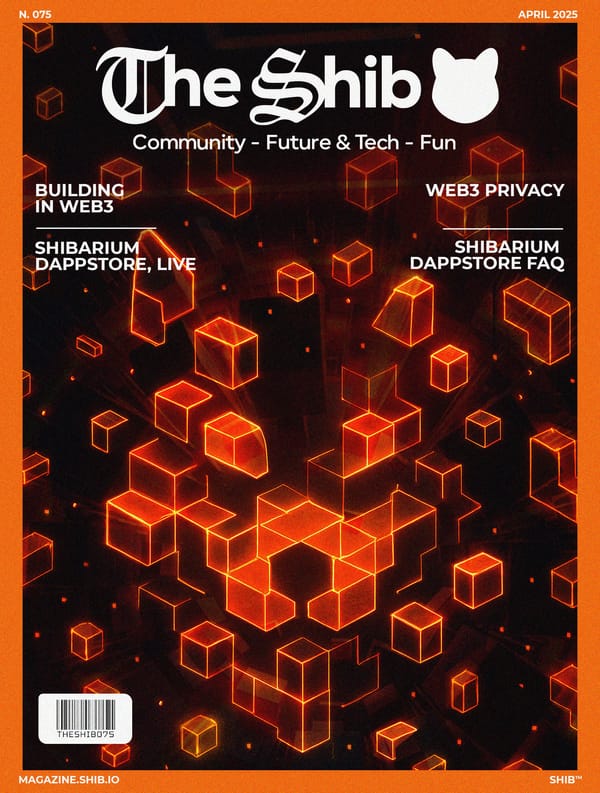AIxCrypto: Convergence or Collision
In the 76th edition, The Shib Magazine explores AI and crypto's convergence. Will their partnership spark innovation or conflict? Dive into the evolving dance of these revolutionary forces shaping the future of tech.

Welcome to the 76th edition of The Shib Magazine! We invite you to explore the fascinating intersection of two revolutionary forces: AI x crypto. Think of it as a high-stakes dance, where both sectors have long danced to separate tunes. Now, as these two formidable forces begin to intersect, a new melody is about to be born. Or has it been born already? Will this AI x Crypto duet lead to a harmonious symphony of innovation, or will it spark a tumultuous clash of elements? Let’s find out together what the future holds when intelligence meets decentralization.
Our Shib Spotlight story sheds light on how Shiba Inu is making bold moves in the AI crypto space. The project is actively integrating AI-powered solutions and developing intelligent agents, representing a strategic effort to harness the combined power of decentralized finance and artificial intelligence. The rewards of such a merger could be transformative.

‘Shy Speaks SHIB’ is on a roll. This time, we focus on Shiba Inu Karma as explained by Shiba Inu Lead Ambassador Shytoshi Kusama and pseudonymous developer Shadow. Find out how this reputation system promotes trust and safety without compromising decentralization. If you believe that reputation must be earned over time within a decentralized community, then you might find this story interesting.
Shibarium’s new rate limits on public RPC endpoints promote decentralization by encouraging node operation among users and developers. If you’d like to learn more about how this works, make sure to read the article by Shibarium Engineering Manager John Doe.
We’ve also prepared a simple yet helpful explainer that dispels misconceptions about Blockchain RPC. Understanding the true role of RPC is vital for addressing current Web3 trust issues and fostering more reliable, transparent interactions within the ecosystem. Clarity on this front is key to overcoming many of the challenges faced by decentralized networks today.
Circling back to the power of AI, we dive even deeper and examine the promising yet complex world of decentralized AI. While promising to democratize access to artificial intelligence, it also raises concerns about control. We explore the opportunities, obstacles, and what the future may hold for this ambitious experiment in decentralization.

We encourage you to stay engaged with the evolving AI x Crypto narratives. These twin engines of technological progress are shaping a future that is both unpredictable and exciting. Will they unite in harmony or clash in chaos? Whatever the answer may be, we’re certain about one thing: the world will be watching.
PREVIEW
AI Crypto Convergence Is Here — Now What?
As thinking machines and trustless ledgers intertwine, the pivotal question emerges: will this AI crypto convergence forge a revolutionary synergy or trigger an unpredictable elemental clash?
By Yona Gushiken
The digital frontier holds its breath as the AI crypto convergence unfolds — or maybe it’s just us reporters holding ours — as Artificial Intelligence and crypto, two modern titans, begin their intricate, almost reluctant dance. This meeting forces a central question on us all: will it spark unparalleled innovation, or shake the very foundations of our digital world? You can almost feel the ground shifting beneath our feet.
There’s a charge in the air, quiet but unmistakable. For years, these two – AI with its brainy algorithms and cryptocurrency with its magic internet money and decentralized dreams – they’ve mostly kept to their own sides of the playground.
One was busy figuring out how to make computers think, or at least fake it convincingly. The other was rewriting the rulebook on what value means, who owns what, and who trusts whom. Revolutionary stuff, both of them, no doubt. But separate.
Well, separate no more. The parallel tracks are definitely starting to look like a railway junction up ahead.
And when two forces this big meet, the interaction – well, it’s got implications. Big ones. Stretching way beyond the usual tech blogs and into the real world, touching how we even think about the future.
It’s not just talk anymore, either. This isn’t some far-off sci-fi plot. It’s happening now, unfolding with a speed that leaves you a bit breathless if you try to keep up.
Those first quiet whispers about AI and crypto getting together? They're a proper hum now, like a massive server farm coming online.
You just sense something significant is taking shape. And with it come the big, knotty questions.
How does AI, with its hunger for data and often centralized brainpower, really mesh with crypto’s love for privacy and letting everyone have a say? And flipping it around, can blockchain, with its transparent, unchangeable records, actually give AI the kind of trust-me-I’m-not-evil backbone it needs for people to really get on board?
This whole dynamic, this push and pull, that's the heart of the AI crypto convergence we're all trying to get our heads around.

Navigating the Potential of AI Crypto Convergence
The questions, honestly, are pretty profound. We’re past the point of just kicking around ideas in whitepapers.
People are building things. Experimenting. Sometimes it works, sometimes it probably blows up spectacularly in a test environment.
You’ve got AI bots trying to outsmart crypto markets – some doing a scary good job of it. You’ve got folks looking at blockchain to prove that AI-generated art or news isn't some deepfake trickery, or to verify the mountains of data these learning models munch on.
Then there are the DAOs, those decentralized groups trying to run things by committee, now peeking at AI to see if it can help them make better decisions or just get the darn operational stuff done more efficiently. And the really out-there stuff?
Platforms where AI agents are not just tools, but actual economic players, owning things, doing jobs, all on the blockchain. If that’s not a direct sign of this powerful convergence, I don’t know what is.
So, this edition of The Shib is wading right into that choppy water. We’re trying to separate the genuine signal from the often deafening noise, looking at the real synergies but also the tough ethical questions and practical headaches that come with any real AI Crypto Convergence.
How could this change what digital identity even means? What does it do to financial markets – make them smarter, or just faster at taking your money? Can it spark new kinds of art, or just flood us with more computer-generated fluff? And what about our online communities, our governance?
It’s all on the table.
And, yeah, we'll look at the "collision" side too. Because let's be real, there are risks.
Centralized AI power is a concern. The thought of super-smart AI being used for next-level crypto scams? Terrifying.
And who’s really in charge when these things start working together? Big questions — not a lot of easy answers.
The landscape’s definitely shifting. Fast. Irrevocably.
Whether this big meet-up of human smarts, artificial smarts, and crypto-secured smarts leads to some golden age, or just a whole new mess of problems, well, that’s the story being written as we speak.
The potential for a game-changing AI crypto convergence is huge, no doubt. But so are the stakes.
Stick with us as we try to make some sense of it.
SPOTLIGHT
Shiba Inu Carves Its Place in the AI Crypto Convergence
As the AI Crypto Convergence unfolds, Shiba Inu is boldly deploying partnered AI technologies and building native intelligent agents to shape its position in this transformative era, drawing significant interest from the digital community.
By Yona Gushiken
As thinking machines meet decentralized ledgers, Shiba Inu navigates the complex AI Crypto Convergence, forging partnerships and developing native tools to define its role in this transformative technological wave.
The digital world watches intently as Shiba Inu steps onto the volatile stage of the AI Crypto Convergence, actively deploying partnered AI solutions and architecting its own intelligent agents in a bold bid to harness the power of these intertwined pieces of technology.
What once seemed like distinct, albeit parallel, technological frontiers are now increasingly overlapping, creating a landscape rife with both unprecedented opportunity and profound new challenges. This isn't merely a trend but an AI crypto convergence that promises to reshape core aspects of how we build, transact, govern, and even define digital identity. Within this dynamic, Shiba Inu is staking its claim.
For years, AI development, particularly in advanced machine learning and large language models, has largely occurred within centralized corporate or academic structures, dependent on vast, often proprietary, datasets and immense computational power. Crypto, conversely, has championed decentralization, user sovereignty, and transparent, permissionless systems.
The question now pressing upon the industry is not just if these paradigms can coexist, but how they might synergize — or where their fundamental tenets might clash.
The Dual Promise: Initial Sparks of AI Crypto Convergence
The potential benefits of a successful AI crypto convergence are compelling and multifaceted. On one hand, AI stands to significantly enhance the crypto space.
Imagine AI algorithms providing sophisticated, real-time analytics for DeFi protocols, optimizing yield farming strategies beyond human capability, or offering personalized, intuitive user experiences within decentralized applications (dApps).
AI could power more intelligent wallet interfaces, assist in the rigorous auditing of smart contracts by identifying potential vulnerabilities, or even drive dynamic NFT projects where the artwork or utility evolves based on AI-driven inputs. For users, this could translate into more efficient markets, more secure platforms, and more accessible decentralized services, lowering the barrier to entry for a broader audience.
Conversely, the foundational technologies of crypto and blockchain offer critical infrastructure and much-needed philosophical grounding for AI. Blockchain’s immutable and transparent ledger can provide verifiable audit trails for AI decision-making processes and, crucially, for the datasets used to train AI models.
This addresses pressing societal concerns about algorithmic bias and accountability. Smart contracts could automate the licensing and royalty payments for AI-generated content or the use of AI services, creating new economic models.
Decentralized storage solutions can offer more resilient and censorship-resistant havens for the massive datasets AI requires. Perhaps most significantly, Decentralized Autonomous Organizations (DAOs) present a novel framework for the collective governance and ethical oversight of AI systems — a pressing need as AI becomes increasingly powerful and autonomous.
Real-World Synergies: Shiba Inu's Partnership with Bad Idea AI
A tangible example of Shiba Inu's commitment to exploring this AI Crypto Convergence is its integration and partnership with Bad Idea AI ($BAD). Described as a decentralized ecosystem merging artificial intelligence, blockchain, and DAOs, $BAD itself is framed as an experiment — "a risky, meme-worthy concoction," as its proponents say, where planning is handed to AI and the community.
In July 2024, Shibarium, Shiba Inu's Layer 2 scaling solution, announced the integration of $BAD onto its platform. Christopher "CJ" Johnson, PhD., known in the crypto space as "Mr. Lightspeed" and the listing manager for Bad Idea AI, expressed significant enthusiasm at the time: “We’re super excited about bringing Bad Idea AI ($BAD) onto Shibarium! This move is a big deal for us as it means faster, cheaper transactions and more utility for our community.”
He further emphasized the mutual benefits, stating, “By adding liquidity to Shibarium, we’re not just improving our tech but also supporting the layer 2 ecosystem... Teaming up with Shiba Inu’s Shibarium aligns perfectly with our vision for decentralization and innovation.”
This collaboration offers clear advantages: Bad Idea AI gains access to Shibarium’s efficient infrastructure, while Shibarium benefits from increased liquidity and an expanded application ecosystem, reinforcing its position as an innovation hub. But the partnership extends beyond token liquidity.
A practical application is already serving the community: the Shib AI bot, powered by Bad Idea AI, is actively deployed across numerous Telegram channels. It serves the Shiba Inu global room and 28 other Shiba Inu ecosystem rooms, reaching over 105,000 users within these dedicated groups.
In total, the bot covers approximately 250 Telegram groups, with a user base nearing a quarter of a million.

Native Intelligence: The Vision for Shiba Inu's AI Agents Dashboard
While partnerships like the one with Bad Idea AI demonstrate external collaboration in the Shiba Inu AI strategy, the ecosystem is also developing native AI capabilities, most notably with its planned "AI Agents Dashboard." This platform aims to enable the DAO-driven creation, ownership, and monetization of AI agents.
The vision here is distinct: rather than a single, centrally controlled AI, Shiba Inu envisions fostering an ecosystem where the community itself contributes to a diverse range of specialized AI agents. Key aspects include user-driven development, where "Shibizens" can collaboratively shape agent functionalities and personalities.
DAO governance would oversee the creation process, ensuring alignment with community interests. Crucially, each AI agent is envisioned to be tokenized as an NFT, granting ownership and a share of any revenue generated by the agent's services. This model attempts to build a self-sustaining loop for Decentralized AI development, directly incentivizing community innovation.
AI's Potential Reach Across the Shiba Inu Ecosystem
Beyond the dedicated AI Agents Dashboard, the fingerprints of AI could touch numerous other facets of Shiba Inu's expansive roadmap:
- Shib: The Metaverse: The promise of an "ultra-realistic metaverse built on Unreal Engine 5.4, complete with advanced AI-driven content generation" explicitly points to AI's role in populating and personalizing virtual worlds. AI could generate dynamic environments, non-player characters (NPCs) with adaptive behaviors, or even assist users in creating their own metaverse assets.
- Karma Engine & Reputation: While not explicitly stated, one could envision AI playing a role in analyzing on-chain behavior to contribute to Karma scores or identify patterns of malicious activity, though this would require careful implementation to avoid bias.
- FHE-Powered Systems: The ecosystem's significant investment in Fully Homomorphic Encryption (FHE) for privacy-preserving identity, transactions, and attestations could become even more critical in an AI-infused future. Training AI models on sensitive user data is a major privacy concern; FHE could theoretically allow AI to operate on encrypted data without ever decrypting it, though this is a highly complex and computationally intensive frontier. The intersection of FHE and AI is a bleeding-edge research area.
- SHIB Business: The description of "AI-driven funding" for new businesses suggests AI tools for assessing project viability or managing investments within this platform.
Navigating the Collision: Risks in the AI Crypto Convergence Era
The path of AI crypto convergence, however, is not without significant obstacles and potential dangers. The centralized nature of many current large AI models, if integrated uncritically into decentralized systems, could reintroduce vulnerabilities or points of control that crypto aims to eliminate.
AI-driven trading algorithms, while offering efficiency, also carry the risk of exacerbating market volatility or enabling new forms of sophisticated manipulation in DeFi. Furthermore, the use of AI in systems determining reputation, governance rights, or platform access demands extreme vigilance against algorithmic bias, which could unfairly marginalize individuals or groups.
And as AI agents become more autonomous and capable of operating on-chain, complex questions of accountability arise: who is responsible if a DAO-governed AI agent malfunctions or causes unintended harm? How are these intelligent entities to be truly controlled and ethically guided in a decentralized framework? These are not merely technical puzzles but deep societal and philosophical challenges.
Shiba Inu's Deliberate Stance in the Algorithmic Age
Shiba Inu's moves in the realm of artificial intelligence—from the tangible partnership with Bad Idea AI and its active community bot to the forward-looking vision of a DAO-governed AI Agents Dashboard—signal a clear intent. The ecosystem is not passively waiting for the AI crypto convergence to happen; it is actively seeking to define its role within this transformative shift.
The journey is nascent, and the challenges are substantial. The "Twin Titans" of AI and crypto offer power that can be used to build more intelligent, efficient, and empowering digital societies, or to create new forms of control and risk.
Shiba Inu's approach — by integrating decentralized AI concepts and fostering community participation — represents one deliberate path through this complex new territory. The success of these initiatives will be a key indicator of how the broader digital economy might navigate the powerful and often unpredictable currents of AI crypto convergence.
SHY SPEAKS SHIB
Shiba Inu Karma: Building a Trust Layer for the Ecosystem
Shiba Inu Karma aims to solve a core Web3 paradox, layering a system of earned reputation over blockchain's anonymity to foster a safer, more rewarding ecosystem.
By Yona Gushiken
The allure of blockchain often rests on its "trustless" nature — the elegant promise that code, not reputation, governs interactions. Yet, anyone who's spent time in the decentralized wild knows the reality: scams flourish, identities are obscured, and knowing who to trust remains a fundamental challenge.
Addressing this head-on, the Shiba Inu core team rolled out Shiba Inu Karma, a system designed not to replace cryptographic security, but to weave a crucial layer of social and behavioral trust into the ecosystem's very fabric. Discussed by lead ambassador Shytoshi Kusama and developer Shadow on the "Shy Speaks SHIB" podcast, Karma represents a calculated move beyond pure code towards community accountability.
Beyond Trustless: The Case for Shiba Inu Karma
"Blockchain loves the word trustless," Kusama acknowledged on the podcast, before immediately pointing out the practical difficulty: "...we deal with so many scams and scammers in this system." The solution proposed isn't to abandon decentralization, but to augment it.
Enter Shiba Inu Karma.
Pseudonymous developer Shadow defined it as fundamentally "identity for trust." The core idea, he explained, is to create quantifiable trust scores based on how users interact with the entire Shiba Inu ecosystem – from swaps on ShibaSwap to engagement with the metaverse or even reading the magazine.
"[It] shows how valued our users are and how they are using our platforms," Shadow noted. This isn't just about tracking clicks; it's about building a verifiable record of participation and behavior over time.
Mechanics: Earning Your Reputation On-Chain
How will these scores work? Shadow clarified that Shiba Inu Karma isn't just a popularity contest, but earned through demonstrable actions, both positive and negative.
Engaging constructively with platforms might earn positive points, while malicious activity or misuse could lead to negative scores. "The overall karma will show us if a user is trustworthy or not," he stated.
Crucially, this system looks backward as well as forward. The plan is to process historical data from the ecosystem's inception.
"We will be including Karma from all the transactions that people have done... from the beginning," Shadow confirmed. This retroactive calculation means longtime positive contributors won't start at zero.
As Kusama put it, the goal is to know "who I can trust instantly," leveraging past behavior to establish an initial trust baseline – a stark contrast to systems like eBay where reputation builds slowly over time.
While full integration with a dedicated identity system is planned for the future, the rollout focuses on this activity-based scoring. It’s a system designed to reflect genuine participation.
Karma vs. Reputation: Understanding the Difference
The team is also developing a related "Reputation" system, but Shadow drew a clear distinction. Shiba Inu Karma, he emphasized, is the objective score derived directly from platform interactions ("the user gets the score by using our platforms").
Reputation, on the other hand, will likely be tied more closely to specific roles within the ecosystem (like developer or moderator) and might incorporate elements of peer-to-peer rating ("rating... given to each other or given by users"). Think of Karma as your activity log score and Reputation as potentially reflecting your standing or role within the community structure.
Putting Shiba Inu Karma to Work
A score is meaningless without consequence. Shiba Inu Karma is designed to directly impact user experience and standing. Shadow highlighted two key applications:
- DAO Integration: Karma scores are set to play a "crucial part" in the ecosystem's Decentralized Autonomous Organization (DAO). A "Karma boost" mechanism could enhance rewards or potentially influence voting power for users with high scores, adding weight to trusted participants' voices.
- Platform Moderation: Negative Karma could have real effects. Shadow suggested that users exhibiting misuse or harmful behavior could potentially be restricted or removed based on their negative score, providing a decentralized moderation tool based on observed actions.
Kusama also hinted at the broader potential, envisioning community members building new applications and incentive systems leveraging the Karma framework, intertwining it with the ecosystem's various tokens and features.
Building the Foundation: An Open Future?
Technically, Shadow described the Karma system as a "marvel," potentially the "first on-chain system" of its kind implemented in this way. He also opened the door for future collaboration, stating the system could eventually be used by external developers wanting to build on top of it or integrate Karma into their own applications via a future onboarding process.
A Calculated Layer of Trust
Shiba Inu Karma represents a deliberate attempt to reconcile the ideals of decentralization with the practical need for accountability and trust. By creating an objective, activity-based scoring system – calculated retroactively and integrated directly into governance and platform access – the Shiba Inu team is building a foundational layer designed to make the ecosystem safer, potentially more rewarding for positive contributors, and ultimately, more trustworthy.
It’s an acknowledgment that while code provides security, understanding who you’re interacting with still matters deeply in navigating the digital economy. Shiba Inu Karma is an interesting development, potentially setting a new standard for how decentralized communities manage reputation and foster accountability.
SHIB DEV INSIGHTS
New Shibarium RPC Limits Could Affect Users — Key Details Inside
Shibarium is implementing rate limits on public RPC endpoints to promote decentralization, encouraging users and developers to run their own nodes for a more resilient and censorship-resistant network.
By John Doe, Shibarium Engineering Manager
The Shiba Inu ecosystem continues its journey toward a fully decentralized network state with Shibarium at its core. As Shibarium's adoption grows, ensuring the network's resilience and decentralization becomes paramount. To that end, we will be implementing rate limiting on public Remote Procedure Call (RPC) endpoints.
Public RPCs have provided a convenient gateway for interacting with Shibarium, allowing users and developers to check balances, send transactions, and build decentralized applications (dApps). However, an over-reliance on a limited number of public RPC endpoints, even those provided by the community, can introduce centralization risks. In a truly decentralized network, access should be distributed and not dependent on a few.
To actively promote decentralization and the long-term health of Shibarium, rate limiting will be applied to public RPC endpoints. This means there will be a limit on the number of requests allowed within a specific timeframe. Specific details on these limits will be announced soon.
This measure isn't about restricting access but rather about encouraging a stronger, more decentralized network. By implementing rate limits, we aim to motivate users and developers with consistent, high-volume needs to adopt more decentralized methods, primarily by running their own Shibarium nodes.
Running your own node offers significant advantages. It provides unrestricted access to the network, limited only by your node's capacity. It increases resilience, ensuring uninterrupted access even if public RPCs face issues. Furthermore, it enhances privacy by routing your requests directly to the network. Most importantly, each community-run node strengthens Shibarium's distributed infrastructure, making it more robust and censorship-resistant.
For many users with infrequent interactions, the upcoming rate limits may have minimal impact. However, for dApps, services, and individuals with high transaction volumes, transitioning to a dedicated node or exploring other decentralized infrastructure solutions is highly recommended to ensure seamless operation and contribute to Shibarium's decentralization.
This step is a natural progression in aligning Shibarium's access layer with the decentralized ethos of the entire Shiba Inu ecosystem. Stay tuned for further announcements regarding the specific rate limits and guides on setting up your own Shibarium node.
For developers looking for alternatives in the meantime, some third-party RPC providers like GetBlock and Nownodes also offer dedicated Shibarium access that may suit specific project needs—though we always encourage community-run infrastructure wherever possible.
Together, we are building a stronger, more decentralized future for Shibarium.
DEFOGGER
What Is Blockchain RPC? Debunking the Myths and Revealing the Truth
Blockchain RPC is the silent middleman — essential, overlooked, and often blamed for problems it didn’t cause (but sometimes did).
By Yona Gushiken
Blockchain RPC is one of the most misunderstood pieces of blockchain infrastructure — and it's time to set the record straight.
Blockchain RPC is the silent workhorse behind every transaction, every swap, every NFT mint — but few understand what it really does. Misunderstood, blamed, or ignored, it is the middleman keeping Web3 running.
RPC stands for Remote Procedure Call. It’s a tech term that sounds complicated but boils down to this — it’s how your apps talk to the blockchain.
If blockchains are the banks, RPC is the teller who takes your request and passes it along. Without RPC, your fancy Web3 apps wouldn’t be able to fetch data or send transactions.
Yet, in crypto conversations, RPC often gets treated like a ghost. But let’s cut through the noise.
Below, we unpack the biggest myths about blockchain RPC — what it really is, what it does, and why understanding it matters.

Myth #1: Blockchain RPC is the blockchain.
Reality: RPC is not the blockchain itself. Think of RPC as the messenger, not the ledger.
The blockchain is a sprawling, decentralized database. It holds the truth: who owns what, which transactions happened, and what the rules are.
RPC, meanwhile, is the communication line. It carries your wallet’s requests to the blockchain and delivers responses back.
When your transaction hangs or your wallet shows errors, it’s easy to blame the blockchain — but most of the time, the problem lies with the RPC node you’re connected to. Nodes can lag, crash, or get overwhelmed, but that doesn’t mean the blockchain itself is broken.
Case in point: Infura, a major RPC provider, suffered a widespread outage in 2021. Ethereum kept running, but apps relying on Infura froze. Users thought the chain was down. It wasn’t. The RPC endpoint was.
Myth #2: Blockchain RPC only fetches data.
Reality: RPC does a lot more than just pull data.
RPC endpoints handle both reading data from the blockchain and broadcasting new transactions. When you send crypto or interact with a smart contract, RPC delivers your instruction to the network.
That means RPCs face constant pressure. Bots, spam transactions, rate limits — they all strain these gateways. When an RPC is congested, everything slows. Your wallet might stall. Transactions might take longer. And you don’t even see what’s happening behind the scenes.
Myth #3: All Blockchain RPCs are the same.
Reality: RPC providers vary widely in speed, reliability, and privacy.
Some RPCs throttle users or charge fees. Others log your activity — including IP addresses — which can be a privacy risk. Most Web3 users unknowingly rely on a handful of large providers like Infura, Alchemy, and QuickNode. That centralizes a crucial part of the network’s infrastructure.
For a space built on decentralization, putting so much trust in a few RPC middlemen is an uncomfortable paradox.
Myth #4: If your wallet freezes, the blockchain is broken.
Reality: The blockchain almost never crashes. It’s robust by design.
When MetaMask or other wallets get stuck, it’s usually the RPC endpoint they’re connected to acting up. That stalled “Confirm” button? Often, the RPC node is overwhelmed or offline.
This subtle distinction matters. Misplacing blame on the blockchain feeds misunderstandings about how Web3 works.
Myth #5: Switching Blockchain RPCs is hard or pointless.
Reality: You can switch RPC endpoints in your wallet settings — and you should.
Many wallets let you swap RPCs, pointing your app to different nodes or providers. Doing this can speed things up, avoid outages, and sometimes give you access to additional features.
Yet most users don’t know this is an option. They stick to default settings, unaware they can dodge slow or broken RPCs by switching.
Myth #6: Decentralized RPC services are everywhere.
Reality: Decentralized RPC networks exist, but they’re still niche.
Services like Pocket Network and Ankr offer alternatives to centralized providers, aiming to build censorship-resistant, distributed RPC infrastructure. But running reliable RPC endpoints is expensive and technically challenging.
Public RPCs offered by blockchain projects — like Shibarium or Polygon — are helping by providing dedicated, trusted endpoints for their ecosystems. These efforts matter because they reduce dependency on third-party RPC middlemen.
What Should Users Do?
Learn how to change RPC settings in your wallet. Next time a transaction stalls, check if the RPC node is down before panicking about the blockchain.
Keep an eye on projects working to decentralize RPC infrastructure. The future of Web3 depends not only on decentralizing the ledger but also the gateways to that ledger.
The Bigger Question
If blockchains promise decentralization, but most users rely on a few centralized RPC gateways, what does that mean for Web3’s trust model? The answer isn’t clear yet — but understanding the real role of RPC is the first step toward fixing it.
ALPHA INSIGHTS
Decentralized AI: Tech’s Biggest Leap—Or Its Next Big Mistake?
Hailed as the next great technological liberation, Decentralized AI promises to put the power of artificial intelligence into everyone's hands—or it could be the very innovation that spirals wildly out of our control.
By Yona Gushiken
Decentralized AI ignites the tech world, heralded by some as the most profound leap in digital power we’ve seen, yet shadowed by the chilling possibility that it could become our next monumental mistake.
Across labs and networks, a radical vision is taking shape: artificial intelligence built not by a select few, but by a global chorus. But as this audacious experiment unfolds, the question hangs heavy: are we on the cusp of democratizing intelligence, or are we unlocking a power we can't hope to contain?
The Unfolding Dream of Decentralized AI
The current landscape of artificial intelligence often feels like a kingdom ruled by a few powerful sovereigns. This concentration of power isn't accidental. But now, a challenge to this reign emerges, fueled by a desire for a more open, equitable AI.
Emad Mostaque, founder of Stability AI, captured this spirit in March 2024 when he resigned as CEO, declaring his intent “to pursue decentralized AI,” because, he insisted, “it is now time to ensure AI remains open and decentralized.”
This call resonates deeply. Benoît Cœuré, head of France’s Competition Authority, put it starkly: AI “is the first technology to be dominated by major players from the outset.” The prospect of Decentralized AI offers a path to disrupt this, to build systems where anyone might contribute, scrutinize, even own the algorithms.
A recent MIT Media Lab report champions this shift, warning that “centralized models, dominated by a few large companies, are reaching their limits,” and concluding that “to unlock the true power of AI, we need a new paradigm: decentralized AI.”
Imagine a world where innovation in artificial intelligence isn't confined to a few coastal innovation hubs. Proponents of Decentralized AI paint this vivid picture: students, startups, individual enthusiasts pooling data and compute. The MIT project sees this fostering true “democratize[d] innovation,” enabling “Individuals and smaller businesses [to] participate in the AI revolution.”
Transparency is another cornerstone; with algorithms running openly, perhaps on blockchains, the hope is to spot bias or abuse more readily. An emerging survey highlighted by Grayscale Research notes that open networks can indeed “reduce bias and improve transparency.” This contrasts sharply with today’s often opaque AI models.
Censorship resistance is also a powerful draw for those exploring Decentralized AI. Current AI giants bake in content filters, leading many users to feel. A decentralized approach could offer a mosaic of AI models, each tailored by its community or DAO, allowing users to choose systems aligned with their values.
This vision, of AI as a “love child” of creativity and blockchain’s openness, inspires advocates who argue, “We should collectively own AI, not just contribute to it.” The promise extends to resilience; Grayscale Research points out how “distributed systems can potentially enhance network resilience,” making Decentralized AI less vulnerable than centralized services to single points of failure.
Decentralized AI: Navigating the Labyrinth of Challenges
Yet, this alluring vision of Decentralized AI – this people’s AI – confronts a gauntlet of formidable hurdles. Taking artificial intelligence out of its carefully controlled corporate nurseries and setting it loose on a global, varied network is an undertaking of immense complexity.
The sheer computational thirst of modern AI is the first barrier. While some, like a Chinese model noted by the BBC, have shown success with “limited compute resources,” most cutting-edge systems demand vast energy. Coordinating this across a distributed network for Decentralized AI is daunting.
Then there's the question of data integrity and model synchronization. Specialized techniques like federated learning offer partial solutions, but, as research indicates, don't eliminate risks like data poisoning. Adding blockchain layers for transparency or payment in Decentralized AI systems also brings overhead, potentially slowing processes.
A systematization report on ArXiv acknowledges that while distribution can tackle issues like bias, it often comes at the cost of efficiency, a trade-off inherent in many Decentralized AI architectures.
Security in a Decentralized AI landscape presents a paradox. Spreading control reduces single points of failure but multiplies potential attack surfaces. If any node in a peer-to-peer AI network is compromised, it could corrupt the shared model.
As cybersecurity expert Bethany Groom (again, attribute if specific, otherwise it’s a generalized expert voice) has explained, enforcing consistent security policies across a widely distributed system is profoundly difficult. Each participant in a Decentralized AI network effectively becomes responsible for their own security, a significant ask.
Perhaps the thorniest challenge for Decentralized AI lies in governance. Who steers the ship? Who is accountable when a distributed AI errs? A Prism Sustainability Directory analysis highlights that “centralized AI ethical frameworks often rely on assumptions of control… challenged by the distributed nature of decentralized AI.”
This accountability vacuum is a serious concern, with some ethicists warning of an “ethical vacuum.” Ethereum’s Vitalik Buterin suggested a hybrid, with AI as the “engine and humans being the steering wheel,” offering “both a form of safety and a form of decentralization” for future AI systems. But even with such ideas, regulation for Decentralized AI significantly lags.
The Unwritten Future of Decentralized AI
The path forward for Decentralized AI is anything but clear. It's a landscape filled with brilliant promise and profound perils. Proponents see it as a necessary evolution, a way to truly “democratize” artificial intelligence and, as MIT’s Ramesh Raskar puts it, “unlock the true potential of AI.” They champion the transparency and resilience inherent in distributed systems.
Critics, however, rightly point to the vanishing “single points of accountability” and the immense technical and ethical hurdles. The dream of a truly open, community-driven Decentralized AI is powerful. But the question remains: can we build the necessary guardrails for such a system, or are we merely trading one set of problems for another, potentially more intractable, set?
The future of Decentralized AI is not yet written. It is being debated, designed, and coded right now, and the outcome of this grand experiment – whether it leads to a more utopian sharing of intelligence or an unmanageable proliferation of digital power – will undoubtedly shape the next era of technology.
The journey of Decentralized AI has only just begun, and its destination remains a profound unknown.
DOGGY BYTES
Shibarium Block Party, Shy Speaks SHIB ft. Paradox, and New Shibarium Builder Spotlight Features
Welcome to Doggy Bytes—your weekly source of the latest and best of the best from the Shiba Inu ecosystem!
By Malaya Ruiz
GM, Shib Army! Welcome to Doggy Bytes, where we celebrate and focus on the positive side of crypto, especially Shiba Inu. This week, find out where the party is on Shibarium and read about the latest projects that graced Shibarium Builder Spotlight. Let’s also recognize the victories we’ve won and give a round of applause to the top dogs that appear in this edition.
Shibarium Block Party: Over 11M and Counting
Shibarium is on fire! With 11,097,260 blocks at the time of reporting, this incredible number highlights the network’s bustling activity, strong security, and enduring popularity. This number is a symbol of continuous growth, frequent transactions, and a committed community driving the layer 2 forward. Here’s to knowing we’ve got more blocks to conquer and victories to celebrate in the years to come!
How to Explain SHIB to Your Grandma
NOWNodes has crafted a great script for you if you’re having trouble making people understand what SHIB is all about! No more scratching your head when trying to enlighten the older generations or those living under a rock about your love for SHIB. Try it out and let us know if you’ve had any luck!
Track Transactions on Shibarium Using NOWNodes
If you're not as tech-savvy as everybody else is in this space, there are numerous resources from our own publications to help simplify things for you. But it’s also impressive how the community continues to expand through other outlets. A great example is this guide from NOWNodes that provides insights into finding the number of transactions on Shibarium. Give it a try now, Shib Army!
Shy Speaks SHIB ft. Shiba Inu Logo Creator Paradox
The podcast we’ve been waiting for weeks finally dropped last week, and we’re still reeling from the joy and excitement! The legendary SHIB logo designer sat down with Shytoshi Kusama to discuss the origin story of the iconic logo, the philosophy behind Oscar, and the importance of branding in Web3. If you’d like a refresher on how it all started, how we got here, and what thought process
es were involved, this episode is definitely worth a listen.
New Shibarium Builder Spotlight Features: TFW NFT and Positions Exchange
“Born from the heart—to cherish cancer warriors and honor our loved ones who’ve faced the fight” – these words encapsulate what the Tutti Frutti Women project represents at its core. Read their beautiful story on The Shib Daily.
Meanwhile, a fresh opportunity awaits traders on Shibarium: Positions Exchange, a native perpetual DEX on the Shibarium testnet. Experience high-speed, gas-friendly leveraged trading of crypto assets—your next move starts here! If you haven’t read our informative feature, check it out on The Shib Daily.
SHIBARIUM
Recent activity on Shibarium reveals a consistent display of growth across multiple metrics. As of Wednesday, over 1.184 billion transactions have been successfully completed. This usually indicates high levels of platform utilization.
The creation of 219.009 million addresses points to a rapidly growing user community, complemented by the launch of 28.661 thousand smart contracts that signal increasing developer interest.
The blockchain has processed 11.099 million blocks, reinforcing its operational depth, while 3.36 million BONE token transfers illustrate active ecosystem participation.
With total accounts reaching 269.607 thousand, these figures collectively affirm Shibarium’s continuous expansion and increasing adoption.
SHIBA INU ECOSYSTEM TOKENS
As of Wednesday morning, SHIB experienced a 1.83% increase, climbing to $0.00001456. The token's 24-hour trading volume also increased by 6.67% to $210.97 million. These figures reflect a strong demand and heightened market activity, respectively.
Meanwhile, its market capitalization rose by 1.84% to $8.58 billion, highlighting an increase in influence and utility.
Shiba Inu Treat (TREAT) recently gained momentum, as shown in these recent statistics. Wednesday morning saw its price standing at $0.002733, a 0.93% increase from the previous day.
Its 24-hour trading volume remains steady at $1.17 million. While there was no increase from the day prior, this number still demonstrates sustained trading activity.
The token’s market cap has reached $2.48 million, highlighting its increasing valuation within the Shiba Inu network.
At 9:13 a.m. ET on Wednesday, BONE traded at $0.3021, marking a slight 0.10% increase over the previous day. The 24-hour trading volume recorded at the time was $8.69 million, which represents a 4.60% increase, indicating a rise in market participation.
BONE’s market capitalization also saw a slight increase of 0.06%, totaling $69.48 million.
Doge Killer (LEASH) traded at $142.09 on Wednesday morning, up 1.65% from the previous day, while its 24-hour trading volume was valued at $1.36 million. These numbers demonstrate a healthy level of market activity.
Additionally, LEASH’s market capitalization rose to $15.11 million, also up by 1.65%.
SHIB BURNS
Shiba Inu's deflationary push remains strong, with 1,095,269,361 SHIB burned as of Wednesday—a 4.30% rise from last week.
Executed via ShibTorch, this sustained activity shows the community’s active role in supporting SHIB’s ecosystem and future price stability.
Wow, over 1.5 million holders and 1.3 followers on CoinMarketCap! #ShibArmyStrong for life. LFG!
SHIB claimed the fifth spot on Crypto Insights’ ‘Most Mentioned Highlight #Memecoins in the last 24h’! I think we can go higher, Shib Army. Let’s sound the alarm and make an even bigger noise on the interwebs!
Huge shoutout to Ragnar for the relentless support for The Shib Magazine and The Shib Daily! We see you, and we admire your authenticity. Keep inspiring all of us here at The Shib!
– Andrew Ng

